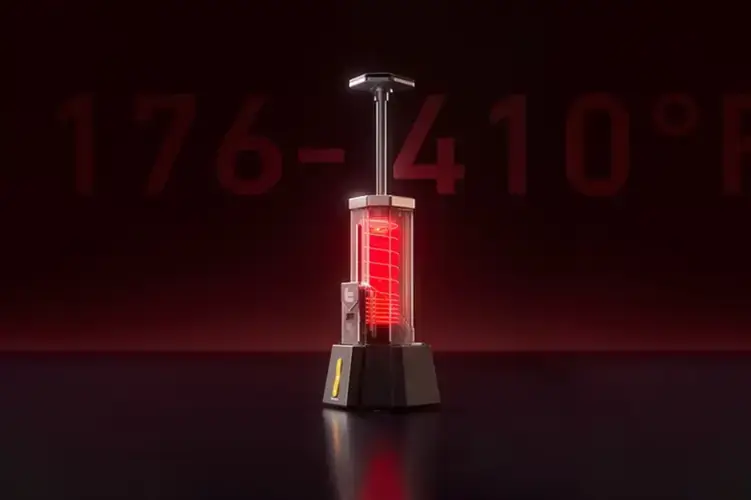FibreSeeker 3 Continuous Fibre 3D Printer on Kickstarter: Carbon Fiber Printing Meets Desktop Affordability
- Michael G.

- 4 days ago
- 6 min read
FibreSeeker 3 Continuous Fibre 3D Printer on Kickstarter is rewriting the rules of desktop manufacturing with a bold promise: aerospace-grade strength without the aerospace-grade price tag. Imagine a 3D printed component strong enough to support a car. That's not marketing hyperbole—it's the power of Composite Fibre Coextrusion technology, and it's now available to makers, engineers, and innovators worldwide. With $1,568,627 pledged of a $50,000 goal, 553 backers, and 43 days to go, this campaign proves the world is ready for continuous carbon fiber printing that doesn't require a factory floor.

Born from the team behind Anisoprint, pioneers in continuous fiber 3D printing for aerospace applications, FibreSeeker 3 represents years of industrial expertise compressed into a desktop-friendly machine. This isn't just another filament printer with fancy features. It's a fundamental shift in what hobbyists and small studios can produce at home.
The Technology Behind the Strength
Composite Fibre Coextrusion Explained
At the heart of FibreSeeker 3 lies proprietary CFC technology that embeds continuous fiber strands directly into melted thermoplastic during extrusion. Unlike chopped fiber or filled filaments that scatter short fragments throughout a print, CFC places full-length fibers precisely where structural integrity matters most. Layer by layer, the printer builds a carbon fiber skeleton that transforms ordinary plastic into engineering-grade components.
The dual-extruder system is the mechanical mastermind here. One nozzle handles standard plastic filament. The other co-extrudes continuous fiber and polymer simultaneously. This setup supports up to three materials in a single print job, enabling complex composite parts with strategically reinforced zones. The result? Parts that achieve up to 900MPa tensile strength—more than twice the strength of 6061 aluminum at half the weight.
Three Printing Modes for Every Application
FibreSeeker 3 doesn't lock you into one approach. Its three distinct modes are indicated by colored lights—green, orange, or purple—so you always know the printer's operational status at a glance.
High Speed Mode activates the FFF nozzle independently, delivering up to 500mm/s print speeds for standard 3D printing applications. When you need rapid prototyping without fiber reinforcement, this mode delivers 10 times faster throughput than industry benchmarks.
High Strength Mode engages both the CFC and FFF nozzles simultaneously, adding a carbon fiber skeleton to your prints. Users can adjust the material ratio to balance strength against weight and cost, making it perfect for functional prototypes that need selective reinforcement.
Hyper Strength Mode runs the CFC nozzle independently, producing parts with tensile strength reaching the full 900MPa ceiling. This mode is designed for mission-critical components that must withstand over 9,000kg of force per square centimeter—heavy-duty jigs, structural brackets, aerospace fixtures, and automotive components that live in the real world, not just on the workbench.
Build Volume and Speed That Don't Compromise
Industrial Scale Meets Desktop Footprint
The 300 x 300 x 245mm build volume allows creators to produce larger prototypes and structural parts without splitting designs into smaller pieces. That's industrial-scale capacity in a machine designed for studios, workshops, and even dedicated home spaces. Whether you're printing UAV frames, robotic joints, bike components, or custom tools, the generous build area eliminates the frustration of segmented assembly.
500mm/s Maximum Print Speed
Speed and precision typically exist in tension, but FibreSeeker 3's active vibration compensation changes that equation. Real-time motion correction algorithms neutralize high-frequency vibrations, maintaining ±0.05mm dimensional accuracy even at maximum 500mm/s speeds. This enables same-day functional prototyping and on-demand batch production without sacrificing the tight tolerances required for end-use parts.
Smart Features That Eliminate Guesswork
Aura Slicer Suite and One-Click Workflow
FibreSeeker 3 ships with dedicated Aura software that analyzes each part's load distribution, fiber path, and material usage. It then generates an optimized toolpath for maximum performance with minimal waste. Users can preview G-code toolpaths and material distribution in virtual print runs before committing filament to the build plate.
The software supports STL, STEP, OBJ, and other open formats. Advanced users can customize support structures with blockers and enforcers, define fiber placement zones with mask tools, and enjoy flexible parameter tuning. For those who want simplicity, one-click slicing handles the heavy lifting automatically.
Built-In Intelligence and Monitoring
An integrated HD camera continuously monitors prints, enabling real-time tracking and smarter failure detection. The AI-powered system can catch issues before they ruin entire build sessions, saving time and expensive carbon fiber material.
The 5-inch full-color touchscreen provides vivid real-time data on temperature, speed, and progress. Users can save and reuse settings instantly, upgrade firmware with one tap, and manage every aspect of a print job without reaching for a computer. Auto-leveling and calibration eliminate manual tweaking, ensuring flawless adhesion and consistent layers from the first print. Filament runout detection pauses jobs automatically when materials run low, allowing mid-print reloads without wasted work.
Material Versatility and Cost Efficiency
FibreSeeker 3 supports a wide range of materials beyond carbon fiber: PLA, PETG, PA, PACF, PC, ABS, and fiberglass. The dual-extrusion system makes it compatible with both proprietary and third-party filaments, though the team recommends their X-Series materials for optimal performance.
The real game-changer is cost. Self-developed carbon fiber filament delivers superior performance at a fraction of market prices. Continuous fiber spools measure 500 meters and cost just $49, representing up to 10 times more affordability than competing solutions. This pricing demolishes the traditional barrier to entry for carbon fiber printing, making industrial-grade composites accessible to individual makers and small studios.
Who Benefits Most From This Machine
FibreSeeker 3 targets three distinct user groups. Home hobbyists and DIY enthusiasts gain access to manufacturing capabilities previously reserved for professionals. Workshop builders and small studios can produce functional parts on demand without expensive CNC setups, molds, or minimum order quantities. Aerospace, automotive, and robotics engineers working on prototypes or small-batch production runs can validate designs with real structural components rather than weak plastic approximations.
The lattice infill structure makes parts stronger where it matters and lighter where it doesn't—perfect for impact absorption, durability, and material cost savings. Whether you're building prosthetics, drone frames, custom fixtures, or performance bike components, FibreSeeker 3 delivers CNC-level strength at a fraction of the cost and time.
Global Shipping Without Hidden Costs
The campaign includes free worldwide shipping with VAT and customs duties covered. What you pledge is exactly what you pay, with no surprise fees at delivery. Shipments begin in February 2026, giving the team time to fulfill what's already become one of the most successful 3D printer campaigns in recent memory.
FibreSeeker 3 isn't just pushing the boundaries of desktop 3D printing—it's erasing them entirely. By bringing aerospace-grade composite manufacturing to makers and small studios at accessible prices, this campaign represents a genuine inflection point for the industry. With over 30 times its funding goal already secured and a month left to run, the message is clear: the future of strong, lightweight, functional 3D printing has arrived. Discover what continuous carbon fiber can do for your next project on Kickstarter today.
FAQ about FibreSeeker 3 Continuous Fibre 3D Printer on Kickstarter
When will FibreSeeker 3 units begin shipping to backers?
Shipments are scheduled to begin in February 2026. The team has built in sufficient production time to ensure quality control and fulfill orders systematically across all backer tiers.
Does FibreSeeker 3 ship to international locations?
Yes, the printer ships worldwide with free shipping included for all backers. VAT and customs duties are covered, meaning your pledge amount includes all costs with no hidden fees at delivery.
What types of projects can I create with this printer?
FibreSeeker 3 excels at producing strong, lightweight functional parts including UAV frames, robotic joints, jigs and fixtures, bike components, custom tools, and even prosthetics. The three printing modes allow you to choose between speed, balanced strength, or maximum 900MPa tensile strength depending on application requirements.
What materials does FibreSeeker 3 support beyond carbon fiber?
The dual-extrusion system works with PLA, PETG, PA, PACF, PC, ABS, fiberglass, and continuous carbon fiber. While it supports open-source compatibility for third-party PLA and PETG plastics, proprietary X-Series materials are recommended for optimal performance, especially when printing with continuous fiber.
How affordable is the continuous carbon fiber filament?
FibreSeeker produces its continuous fiber in-house, keeping costs remarkably low. Each 500-meter spool of X-CCF continuous carbon fiber costs just $49, representing up to 10 times more affordability compared to competing materials without sacrificing performance or structural integrity.



















.png)









